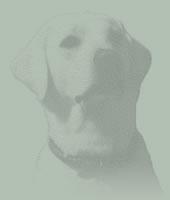Veterinary Topics: Obstetrics
See Also: Feeding
the Adult Labrador | Reproduction | Preventative
Medicine
Neonatal
Care | Feeding Your New Puppy | Crate
Training | Ask the Doc
 The
Eye of the Tiger The
Eye of the Tiger
Having delivered literally thousands of Thoroughbred foals
and hundreds of puppies over the years, let me say that I
have found myself in some totally unbelievable circumstances
that would raise more than just a few eyebrows. How about
being "shoulder-deep" into the reproductive tract of some
of the most valuable mares in central Kentucky attempting
to deliver a "problem child" who thought he could be the
first ever to come into the world sideways. Or being bathed,
head to toe, in equine amniotic fluid in the middle of winter
at two in the morning? That will not only raise your brow,
but trust me, it will bring a few tears to your eyes as well.
It's very potent stuff!
But before I discuss a bit of the more "normal" situations
you're likely to encounter when whelping man's best friend,
I must share with you one of the most fascinating
aspects of the equine species that I have ever experienced.
Although I have never seen this phenomenon with the many
dogs I have whelped, there have been several times when the
term "bitch" would more accurately describe the foaling mare
than her canine counterpart.
The scenario begins with a midnight call from the night
watchman who senses that something is not right with the
mare in the foaling stall. "She broke her water, Doctor Joe,
but nothing's happened and she's steaming pretty good. She
keeps pawing at the ground and walking in circles around
her stall. Then she lays down on her side and groans a lot
but I can't see the hooves of the baby like I normally do
when she pushes. I think you better come quick Doctor".
I can tell from past experience that there's trouble. This
particular foaling man has seen plenty of normal deliveries.
He has learned through experience what I believe is the most
important thing to know.... the normal from abnormal. And
having worked with him for years, I know he's very concerned.
It takes me 20 minutes to get up, get dressed and drive into
the foaling barn.
I arrive to find a very anxious man who has a stainless
steel bucket filled with steaming hot water and disinfectant
waiting outside the mare's stall. Although it's only 25 degrees
outside, I take off my coat and sweatshirt and quickly get
into a clean pair of short-sleeve coveralls. After a quick
scrub, we enter the stall to find the mare lying rather helplessly
on her side with her head stretched flat out on the straw
bedding. She refuses to get up, so I jump down and work on
her terms. I'm looking to identify the reason why the foal
hasn't come forth after so many incredibly powerful contractions.
Each time I attempt a further exam of the birth canal, her
contractions feel as if they're going to snap my arms off
at the elbow. Any attempts to comfort her are met only with
visceral groans.
As a veterinarian I have been around any number of sick
or near-death animals that required intense treatment to
maintain their life. But to me, nothing has ever matched
the picture of desperation and sheer helplessness more than
the eye of the mare unable to deliver her baby. It is a look
that transcends the species barrier and translates to one
phrase........please help me!
My decision is made quickly. The night watchman calls for
several assistants who will be needed for physical support.
We must anesthetize the mare with a short acting anesthetic
and muscle relaxant to stop all abdominal contractions. That's
the only way the foal, abnormally twisted in the uterus,
can be repositioned to facilitate a manual delivery. It would
be futile to attempt such manipulations against the force
of nature.
The help arrives, I administer the anesthetic, then quickly
begin to explore the birth canal to locate the forelimbs,
head and neck of the foal. We all breath a sigh of relief
that he is still alive when I stick my fingers in his mouth
and describe to the others his attempts to bite them. Acting
quickly as the mare rests, I manage to reposition the foal
and apply obstetrical straps to each front limb. Then with
the help of two assistants, each one applying firm pressure
on the straps, we pull with all of our strength to guide
the foal through the birth canal and out onto his bed of
straw.
Having no time to waste, the foal is separated from the
placental membranes, towel dried to help keep him warm and
moved to a safe corner of the stall near his mother's head.
As mom begins to nicker signaling her quick return to consciousness,
we gather around to position ourselves to assist her when
she makes her first attempts to rise. Get up too quickly
and she could easily fall and seriously injure herself or
those of us around her. So it's important to keep her as
calm as possible before she rises. We let her see and smell
her new baby as this helps to keep her content for a few
extra minutes while she licks him and nickers back and forth
to him. It's now beginning to make sense to her all of a
sudden. Her voice becomes more assertive. She looks around
and wonders why all of these humans are hovering around her
baby. Yes the baby! Why are they so close to my baby! With
a rush she jumps to her feet and puts her body between her
newborn and the human intruders. Ears pinned flat against
her neck, she bares her teeth at us in a vicious gesture
sending us scrambling out the door to safety. There is no
question that she would seriously hurt anyone who dares to
defy her warnings.
Outside the stall we all breath a sigh of relief. As much
for saving the mare and foal as for getting out of her stall
in time to save ourselves from certain injury! While we smile
at each other for a job well done, I shake my head in complete
and utter amazement at the transformation process we were
just witness to and intimately a part of!
Coming Soon: Recognizing labor and assisting delivery in
the Labrador Retriever.
back to top
|




 The
Eye of the Tiger
The
Eye of the Tiger